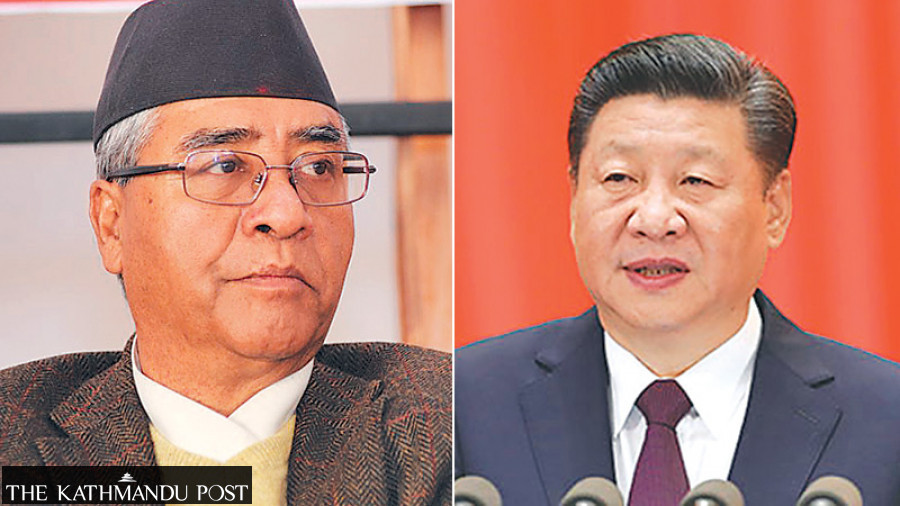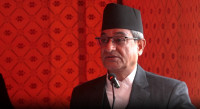National
Take up border issue with Beijing, Home Ministry asks Foreign Ministry
Communication comes ahead of the 60th anniversary of signing of Nepal-China Boundary Treaty, which called for joint inspection every 10 years.
Anil Giri
A week after a panel submitted its report recommending the formation of a joint boundary inspection team to address the boundary issues between Nepal and China in line with the Nepal-China Joint Boundary Treaty, the Ministry of Home Affairs on Monday wrote to the Ministry of Foreign Affairs to take the matter up with Beijing.
The Sher Bahadur Deuba government on August 21 formed the panel led by Jaya Narayan Acharya, a joint-secretary at the Ministry of Home Affairs, to study the boundary issues along the Nepal-China border, especially in the region from Limi Lapsa to Hilsa of Humla.
The Acharya-led panel submitted its report to Home Minister Balkrishna Khand last Sunday and suggested that the government resolve those issues by forming a joint boundary inspection group comprising experts from Nepal and China.
“We have already written to the Foreign Ministry to take the matter up with China so as to resolve the issues on the basis of suggestions provided by the Achayra-led panel,” Dil Kumar Tamang, deputy spokesperson for the Home Ministry told the Post. “We cannot disclose the content of the report, but in the letter to the Foreign Ministry, we have provided the suggestions made by the panel so as to resolve the outstanding matters, if any, between the two countries.”
The Home Ministry’s letter to the Foreign Ministry comes a day ahead of the 60th anniversary of the signing of the Nepal-China Boundary Treaty.
Nepal and China had signed the Sino-Nepal Boundary Agreement on March 21, 1960 by two prime ministers–Bishweshwar Prasad Koirala and Chou En-lai. After signing the protocol, the two sides signed the Boundary Treaty on October 5, 1961. It was signed by then king of Nepal Mahendra Bir Bikram Shah Dev and chairman of the People’s Republic of China, Liu Shai-Chi.
The treaty determined the border line in a formal and scientific manner that had remained unchanged for hundreds of years, according to Buddhi Narayan Shreshta, former director general of the Department of Survey who is considered the authority on border issues. The treaty not only solved the minor scuffles but also ensured the borderline as a symbol of peace and friendship.
“The main objective of the treaty was to respect the traditional boundary line and to delineate and demarcate the border scientifically,” Shrestha told the Post. “As per the treaty, both sides should have completed the joint inspection every 10 years. Had we followed that routine, the current issues like in Humla would not have surfaced.”
Though the Acharya-led panel’s report has not been made public, officials say during its field inspection, it found that some boundary pillars in Humla were repaired and fenced without the knowledge of the Nepali side.
The panel consisted of representatives from the Nepal Police, the Armed Police Force, the National Investigation Department and the Department of Survey.
Though it is not known who wired and who repaired them, to address those issues, the panel has suggested forming a joint inspection team comprised of experts from both countries—Nepal and China.
“As per the suggestion to pursue the matter diplomatically, we have urged the Foreign Ministry to follow it up with China,” said a Home Ministry official who spoke on condition of anonymity because he was not authorised to speak to the media. “A communication to China would also mean a proposal to conduct the joint boundary inspection, which has not taken place since 2006.”
After the last joint border inspection in 2006, according to officials, a protocol was prepared, but due to disputes over the height of Mt Everest and issues with the alignment of boundary pillar number 57 in Dolakha district, the signing could not take place.
“As per the boundary treaty, we must conduct joint inspection of the boundary every 10 years. We did in 2006 but it has become outdated now,” said Madhusudan Adhikari, another former director general of the Department of Survey. “Obviously it’s better to conduct a fresh joint inspection.”
As per Article 3 of the Nepal-China Boundary Treaty, the two countries “shall set up permanent boundary markers as necessary on the boundary line between the two countries, and then draft a protocol setting forth in detail the entire boundary line and the location of the permanent markers, with detailed maps attached thereto showing the boundary line and the location of the permanent boundary markers.”
That there were some border issues between Nepal and China in Humla district first surfaced when some local representatives reported that China had encroached upon Nepali territory between border pillar numbers 11 and 12 by changing the alignment of pillar number 12. The land between pillars 11 and 12 falls in a high-altitude area and the people from both sides were using it as a grazing site.
Last week, Acharya, who led the study panel, told the Post that they conducted a field visit and interacted with local people and stakeholders before preparing the report.
“Whether there indeed is encroachment can be established only after an inspection and a thorough study by a joint team,” said Acharya. “There is a need to first investigate who carried out repairs of some boundary pillars and who fenced them. These activities, however, are against the Nepal-China Boundary Protocol of 1963.”
After the signing of the treaty in 1961, the two sides in 1963 had completed the demarcation and agreed to install 79 major pillars and 20 sub-pillars. Later Nepal and China renewed the boundary protocol in 1979 and 1988.
According to Shrestha, after the completion of the joint boundary demarcation physically on the ground, Nepal-China Boundary Protocol was signed on January 20, 1963 by Tulsi Giri, then vice-chair of Council of Ministers and foreign minister of Nepal, and Chen Yi, then Chinese vice-premier and foreign minister.
“After 15 years, joint inspection of the boundary was made with the repair, maintenance and construction of the damaged pillars. In the same way the Second Boundary Protocol was signed on November 20, 1979 by Nepal’s then foreign minister KB Shahi and Chinese foreign minister Huang Hua,” said Shrestha. “The Third Boundary Protocol was signed on December 6, 1988 by foreign ministers of Nepal and China–Shailendra Kumar Upadhyaya and Qian Qichen.”
After Nepal and China conducted a joint field visit in 2006 and prepared the protocol in 2007, the two sides agreed to sign the Fourth Boundary Protocol in 2010. The Chinese side had called a meeting in Xi’an of China, but it was later called off by the Nepali side.
Then there was pause between both sides. After both sides agreed to jointly announce the height of Mt Everest, the Department of Survey had proposed a joint inspection of the border.
“We have not received a reply from the Chinese side,” a senior official at the Department of Survey told the Post.
Nepal and China jointly announced the height of Mt Everest on December 8 last year, declaring the world’s tallest peak’s height at 8,848.86 metres.
Nepal and China earlier had a dispute over the alignment of pillar number 57
in Dolakha and the height of Mt Everest. The pillar was found missing and there was an issue of marking while China did not recognise the snow height of Mt Everest that measured 8,848 metres.
The border issue with the northern neighbour recently surfaced after
Jeevan Bahadur Shahi, a Nepali Congress provincial lawmaker, reported that
China had changed the alignment of the boundary pillar number 12. He had presented his field study report at the Karnali Provincial Assembly in November last year. He had also called on the Karnali provincial government and the federal government in Kathmandu to carry out a detailed inspection by a joint team of Nepal and China.
After Shahi’s report made it to public domain, on December 4 last year, then foreign minister Pradeep Gyawali had said there was no encroachment by China in the Limi area of Humla.
A joint-secretary at the Ministry of Land Management said a permanent body led by the Ministry of Foreign Affairs needs to be instituted, which can meet with its counterpart every year and follow up on the issues.
“Both Nepal and China have failed to follow the treaty and the protocol as at times there is a joint secretary from the Foreign Ministry and at other the director general of the Department of Survey tasked to follow up on the matter,” said the joint secretary who also spoke on condition of anonymity citing sensitivity of the matter. “Unless we institute a permanent body, such irritants will continue to emerge once in a while.”




 7.12°C Kathmandu
7.12°C Kathmandu















